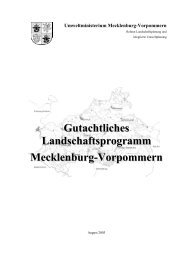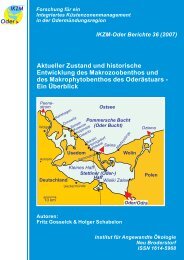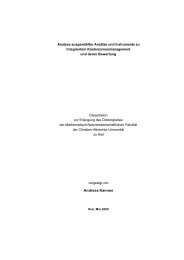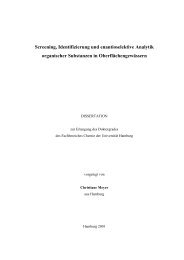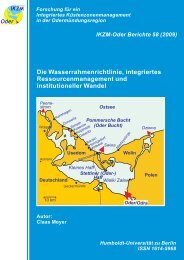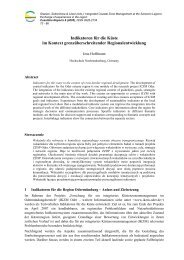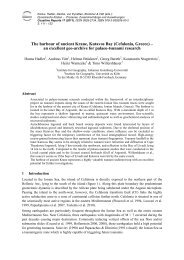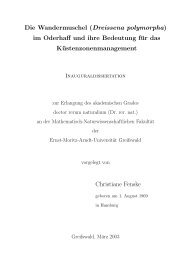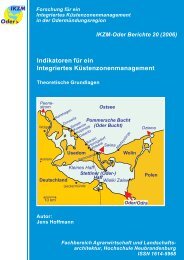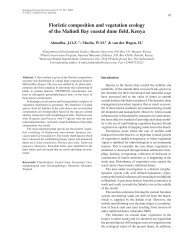The impact of grazing on spider communities in a mesophytic ...
The impact of grazing on spider communities in a mesophytic ...
The impact of grazing on spider communities in a mesophytic ...
You also want an ePaper? Increase the reach of your titles
YUMPU automatically turns print PDFs into web optimized ePapers that Google loves.
- <str<strong>on</strong>g>The</str<strong>on</strong>g> <str<strong>on</strong>g>impact</str<strong>on</strong>g> <str<strong>on</strong>g>of</str<strong>on</strong>g> <str<strong>on</strong>g>graz<strong>in</strong>g</str<strong>on</strong>g> <strong>on</strong> <strong>spider</strong> <strong>communities</strong> <strong>in</strong> a <strong>mesophytic</strong> calcareous dune grasslands - 139<br />
Fig. 1. N<strong>on</strong>-metric multi-dimensi<strong>on</strong>al scal<strong>in</strong>g <str<strong>on</strong>g>of</str<strong>on</strong>g> the pitfall<br />
traps and superpositi<strong>on</strong> <str<strong>on</strong>g>of</str<strong>on</strong>g> the <strong>in</strong>dicator species, determ<strong>in</strong>ed<br />
by TWINSPAN. Pitfall traps are <strong>in</strong>dicated by their code (see<br />
Table 1). Indicator species: TYPHDIGI: Typhochrestus digitatus;<br />
MASTARIE: Mastigusa ariet<strong>in</strong>a; ARGESUBN: Argenna subnigra.<br />
w<strong>in</strong>ter vegetati<strong>on</strong>. Group 01 c<strong>on</strong>ta<strong>in</strong>s species without<br />
clear correlati<strong>on</strong> with the envir<strong>on</strong>mental parameters <strong>in</strong>volved,<br />
while the rema<strong>in</strong><strong>in</strong>g groups comprise <str<strong>on</strong>g>of</str<strong>on</strong>g> species<br />
typical <str<strong>on</strong>g>of</str<strong>on</strong>g> grazed, short vegetati<strong>on</strong>. Only group 001 is<br />
characterized by species with a negative correlati<strong>on</strong><br />
with grass-layer coverage.<br />
Impact <str<strong>on</strong>g>of</str<strong>on</strong>g> cattle <str<strong>on</strong>g>graz<strong>in</strong>g</str<strong>on</strong>g> <strong>on</strong> the <strong>spider</strong> assemblages<br />
S<strong>in</strong>ce total numbers <str<strong>on</strong>g>of</str<strong>on</strong>g> trapped <strong>spider</strong> <strong>in</strong>dividuals<br />
per pitfall are positively correlated with the number <str<strong>on</strong>g>of</str<strong>on</strong>g><br />
different species per pitfall (Spearman correlati<strong>on</strong>, R =<br />
0.566; p = 0.004), an estimate <str<strong>on</strong>g>of</str<strong>on</strong>g> species richness was<br />
made by transform<strong>in</strong>g the observed number <str<strong>on</strong>g>of</str<strong>on</strong>g> species<br />
per trap <strong>in</strong>to an ‘expected’ number <str<strong>on</strong>g>of</str<strong>on</strong>g> species per 100<br />
trapped <strong>in</strong>dividuals (Fig. 2). Stati<strong>on</strong>s B and C2 are<br />
characterized by the highest species richness, while<br />
species richness <strong>in</strong> the three others is approximately<br />
equal. Kruskal-Wallis ANOVA <str<strong>on</strong>g>of</str<strong>on</strong>g> the data <str<strong>on</strong>g>of</str<strong>on</strong>g> the five<br />
stati<strong>on</strong>s revealed no overall difference <strong>in</strong> expected<br />
species numbers per treatment (p > 0.05), although<br />
standard deviati<strong>on</strong>s do not overlap between B or A2<br />
and B and C1.<br />
Species which take significant advantage <str<strong>on</strong>g>of</str<strong>on</strong>g> <strong>in</strong>tensive<br />
<str<strong>on</strong>g>graz<strong>in</strong>g</str<strong>on</strong>g> (U test, p < 0.05) <strong>in</strong>clude Erig<strong>on</strong>e atra,<br />
Pardosa m<strong>on</strong>ticola and Pelecopsis parallella (Table 5).<br />
In c<strong>on</strong>trast, Bathyphantes gracilis, Lepthyphantes tenuis,<br />
and Pardosa nigriceps benefit from a rough and n<strong>on</strong><br />
cattle-grazed grass layer. <str<strong>on</strong>g>The</str<strong>on</strong>g> ‘distance from rough vegetati<strong>on</strong>’<br />
is an important factor, which determ<strong>in</strong>es the<br />
presence <str<strong>on</strong>g>of</str<strong>on</strong>g> certa<strong>in</strong> species <str<strong>on</strong>g>of</str<strong>on</strong>g> the short-grazed grasslands:<br />
e.g. Centromerus sylvaticus, Trochosa terricola and<br />
Xysticus cristatus, occur <strong>in</strong> significantly (U-test, p < 0.05)<br />
higher numbers <strong>in</strong> the proximity <str<strong>on</strong>g>of</str<strong>on</strong>g> taller (denser)<br />
vegetati<strong>on</strong>. Only Trichopterna cito has a higher (U-test,<br />
p < 0.05) populati<strong>on</strong> density with <strong>in</strong>creas<strong>in</strong>g distance<br />
from the ungrazed areas (Table 5).<br />
<str<strong>on</strong>g>The</str<strong>on</strong>g> temporal activity patterns (number <str<strong>on</strong>g>of</str<strong>on</strong>g> <strong>in</strong>dividuals<br />
caught per treatment per m<strong>on</strong>th) for the typical open<br />
ground species Pardosa m<strong>on</strong>ticola <strong>in</strong> treatments B, A1<br />
and A2 are presented <strong>in</strong> Fig. 3. Although total catch<br />
numbers are different, it is possible to dist<strong>in</strong>guish two<br />
activity peaks <strong>in</strong> the treatments A1 and A2 and <strong>on</strong>ly <strong>on</strong>e<br />
<strong>in</strong> B. <str<strong>on</strong>g>The</str<strong>on</strong>g> first peak can be assumed to be due to active<br />
search<strong>in</strong>g for copulati<strong>on</strong> partners. Female activity causes<br />
the sec<strong>on</strong>d peak, as they search for optimal microclimatological<br />
breed<strong>in</strong>g c<strong>on</strong>diti<strong>on</strong>s (B<strong>on</strong>te 1996). S<strong>in</strong>ce<br />
rabbit <str<strong>on</strong>g>graz<strong>in</strong>g</str<strong>on</strong>g> is <strong>in</strong>sufficient (due to a small populati<strong>on</strong><br />
size) to keep the vegetati<strong>on</strong> short <strong>in</strong> late spr<strong>in</strong>g, P.<br />
m<strong>on</strong>ticola disappeared <strong>in</strong> the B stati<strong>on</strong> expla<strong>in</strong><strong>in</strong>g the<br />
lack <str<strong>on</strong>g>of</str<strong>on</strong>g> a sec<strong>on</strong>d activity peak. On the c<strong>on</strong>trary, cattle<str<strong>on</strong>g>graz<strong>in</strong>g</str<strong>on</strong>g><br />
ensures short vegetati<strong>on</strong> dur<strong>in</strong>g the whole seas<strong>on</strong><br />
result<strong>in</strong>g <strong>in</strong> the c<strong>on</strong>t<strong>in</strong>uous presence <str<strong>on</strong>g>of</str<strong>on</strong>g> this Lycosid<strong>spider</strong>.<br />
<str<strong>on</strong>g>The</str<strong>on</strong>g> time period <strong>in</strong> which the first activity peak<br />
appears <strong>in</strong> the three treatments varies. <str<strong>on</strong>g>The</str<strong>on</strong>g> sec<strong>on</strong>d peak<br />
<strong>in</strong> July appears <strong>in</strong> both the two cattle-grazed stati<strong>on</strong>s,<br />
suggest<strong>in</strong>g a regular distributi<strong>on</strong> <str<strong>on</strong>g>of</str<strong>on</strong>g> this species all over<br />
the habitat. C<strong>on</strong>sequently, we may <strong>in</strong>terpret the three<br />
spatially and temporally succeed<strong>in</strong>g activity peaks as<br />
seas<strong>on</strong>al migrati<strong>on</strong> <str<strong>on</strong>g>of</str<strong>on</strong>g> adults <str<strong>on</strong>g>of</str<strong>on</strong>g> P. m<strong>on</strong>ticola from the<br />
hibernati<strong>on</strong> habitat (rough, n<strong>on</strong>-cattle-grazed edge) to<br />
the reproducti<strong>on</strong> habitat (short-grazed dune grasslands).<br />
Table 4. Best variable comb<strong>in</strong>ati<strong>on</strong>s and the percentage expla<strong>in</strong><strong>in</strong>g value <str<strong>on</strong>g>of</str<strong>on</strong>g> the MDS ord<strong>in</strong>ati<strong>on</strong>. Bold: the best expla<strong>in</strong><strong>in</strong>g subset<br />
<str<strong>on</strong>g>of</str<strong>on</strong>g> habitat variables. For key to the habitat variables: see legend Table 2.<br />
Harm<strong>on</strong>ic rank correlati<strong>on</strong> (weighted Spearman)<br />
k Best variable comb<strong>in</strong>ati<strong>on</strong>s (ρw )<br />
1 WC (0.553) DI (0.489) SC (0.375) HE (0.294) TO (0.247)<br />
2 DI, WC (0.724) DI, SC (0.614) DI, TO (0.555) RP, WC (0.527) .....<br />
3 DI, RP, WC (0.737) DI, WC, SC (0.727) DI, SC, TO (0.651) DI, WC, TO (0.633).....<br />
4 DI, RP, SC, WC (0.774) DI, RP, WC, TO (0.675) DI, RP, SC, TO (0.672)...<br />
5 DI, RP, SC, WC, TO (0.738) DI, RP, WC, SC, HE (0.715)....<br />
6 DI, RP, SC, WC, HE, TO (0.711) DI, RP, CE, SC, WC, HE (0.593) ....



